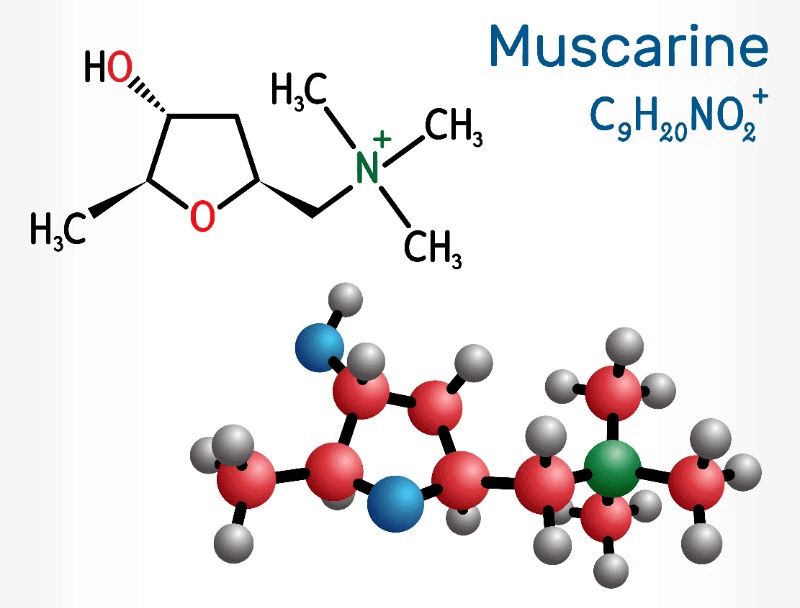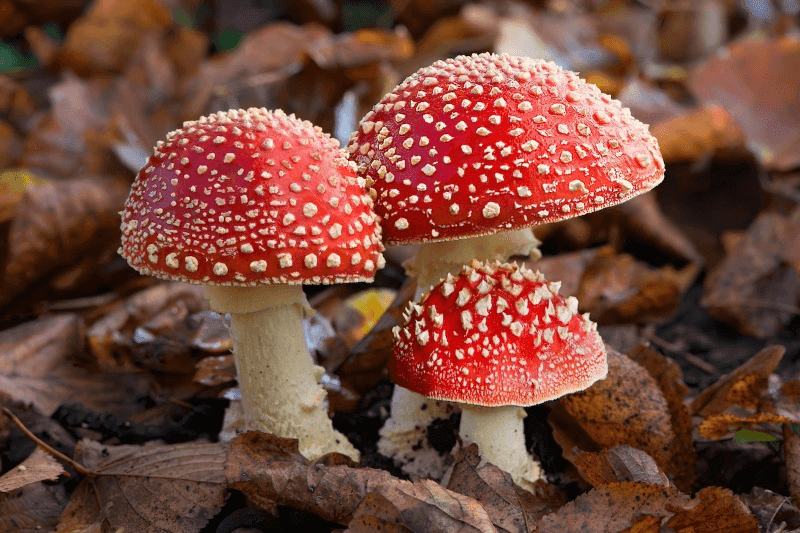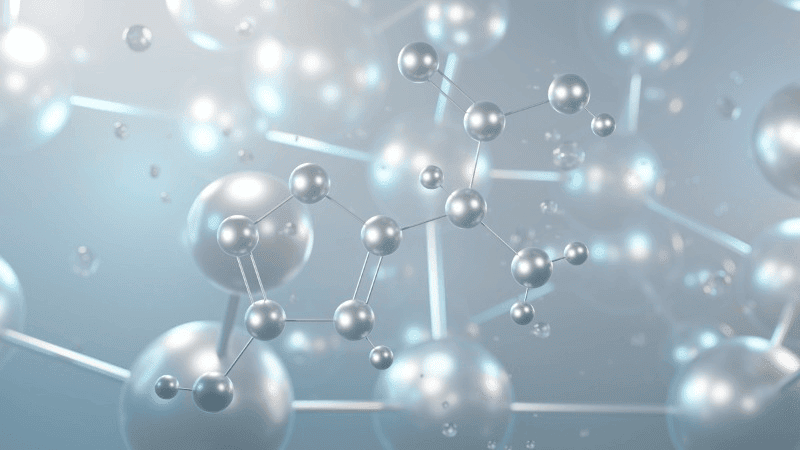Table of Contents
Muscarine, a muscarinic agonist with hallucinogenic properties, stands as a pivotal compound in the realm of toxicology and pharmacology, wielding a profound influence on both academic research and practical applications, including therapeutic use and understanding muscarinic manifestations. This alkaloid substance, predominantly found in certain mushroom species, has sparked significant interest due to its distinctive effects on the human nervous system’s neurons and ganglion cells. By binding selectively to muscarinic acetylcholine receptors, muscarine unveils crucial insights into neurotransmitter functions, proteins release, and their implications for health, disease, and mushroom poisoning. Its role extends beyond mere toxicity; it serves as a vital tool in neurological studies, paving the way for advancements in treating conditions like Alzheimer’s disease, focusing on proteins related to early onset. Understanding muscarine’s properties, species, and proteins not only enriches our knowledge of natural poisons but also highlights the intricate balance between neurotoxicity and therapeutic potential, including the release chapter.
Key Takeaways
- Muscarine, a compound discovered from certain mushrooms, has a unique structure that enables it to mimic the neurotransmitter acetylcholine, affecting the parasympathetic nervous system.
- Its mechanism of action primarily involves stimulating muscarinic acetylcholine receptors, leading to various physiological effects such as decreased heart rate and increased secretion of bodily fluids.
- Despite its potential medical uses in treating diseases like glaucoma and dry mouth, muscarine’s therapeutic application is limited due to its side effects, including excessive sweating, salivation, and visual disturbances.
- The safety profile of muscarine necessitates caution, as its ingestion can lead to severe poisoning, underscoring the importance of understanding its pharmacological properties and toxicology.
- Legally, muscarine’s status varies by jurisdiction, but it generally falls under regulations concerning poisonous substances, reflecting its dual nature as both a potential medicine and a toxin.
- A comparative analysis with other cholinergic agents highlights muscarine’s unique role in medical research and toxicology, offering insights into the broader field of neuropharmacology.
Muscarine Discovery

History Insight
Muscarine was discovered in the 19th century. Scientists found it in certain mushrooms. These discoveries shed light on how some mushrooms affected people through the release of proteins.
The compound comes from Amanita mushrooms. People knew these mushrooms for their strong effects. Historically, muscarine was used because of its hallucinogenic properties. This made it both fascinating and dangerous.
Researchers were intrigued by its potent effects on the human body. The study of muscarine helped scientists understand more about neurochemistry, including proteins, their release, and onset.
Amanita Mushrooms

Amanita muscaria mushrooms are the primary natural source of muscarine. They grow in temperate and boreal regions around the world.
Not all Amanita species contain this compound, though. It’s important to know which ones do.
For example, Amanita dealbata is known to contain muscarine. This knowledge helps mushroom gatherers stay safe.
These mushrooms have a distinct appearance that can help identify them. However, caution is always advised when dealing with wild mushrooms due to potential toxicity.
Muscarine Structure
Reactivity
Muscarine shows stability under normal conditions. This means it does not easily change or degrade when stored properly. However, its reactivity changes with strong oxidizing agents. Here, muscarine can react vigorously.
Muscarine also hydrolyzes in alkaline solutions. When exposed to a base, it breaks down into simpler compounds. This reaction is crucial for scientists studying its properties and effects.
Furthermore, muscarine forms salts with acids. This ability to combine and form stable compounds makes it interesting for various chemical studies and applications.
Classification
Muscarine is known as a natural alkaloid. Alkaloids are compounds mostly found in plants that have significant physiological effects on humans and animals.
It acts as a non-selective muscarinic agonist. This means muscarine can bind to muscarinic acetylcholine receptors in the body without preference for any specific type of receptor.
Unlike nicotine and other psychoactive substances, muscarine has a distinct mechanism of action. It specifically targets parts of the nervous system different from those affected by nicotine.
Mechanism of Action
Neurotransmitter Role
Cholinergic Interaction
Muscarine binds to muscarinic acetylcholine receptors. This action mimics the neurotransmitter acetylcholine in the parasympathetic nervous system. It plays a critical role in transmitting nerve signals.
Muscarine does not affect nicotinic acetylcholine receptors, focusing its effects on specific parts of the body. Its selective interaction emphasizes its importance in studying neurotransmission and drug development.
Voltage-Gated Channels
Muscarine influences potassium and calcium channels but does it indirectly. It uses G-protein coupled mechanisms for this purpose. Such actions can alter heart rate and glandular secretions significantly.
It does not directly block or open ion channels, making its mechanism unique among similar compounds. This indirect influence showcases muscarine’s complex interaction within biological systems.
Peripheral System Effects
Muscarine induces several physiological responses known collectively as SLUDD: salivation, lacrimation, urination, digestion, and defecation. These effects highlight muscarine’s impact on the peripheral nervous system.
Muscarine decreases heart rate and blood pressure while increasing glandular secretions. These changes underscore its potent effects even at low doses.
- Pros:
- Induces vital bodily functions.
- Can be studied for therapeutic purposes.
- Cons:
- Overdose can lead to severe symptoms.
- Specific antidotes are required for poisoning cases.
Muscarine Effects

Toxicity Signs
Muscarine, a potent toxin found in certain mushrooms, triggers distinctive signs of toxicity. These symptoms typically surface within 30 minutes to 2 hours following ingestion. Individuals may first notice excessive sweating, a hallmark of muscarine’s impact on the body’s sweat glands.
Those affected often experience blurred vision and significant abdominal pain. The blurred vision results from muscarine’s effect on the eye muscles, complicating focus adjustments. Abdominal discomfort arises as the digestive system reacts adversely to the toxin.
In more severe cases, muscarine poisoning can lead to life-threatening conditions such as severe bradycardia and hypotension. Bradycardia refers to an abnormally slow heart rate, while hypotension is characterized by low blood pressure. Both conditions are serious and require immediate medical attention.
Clinical Symptoms
The clinical presentation of muscarine poisoning is marked by an overstimulation of bodily secretions including profuse sweating, salivation, and tears. This trio underscores the body’s attempt to rid itself of toxins through increased fluid production.
Victims also suffer from visual disturbances, struggling with their sight due to the excessive secretion affecting their eyes’ normal functioning. Difficulty breathing is another common symptom; it reflects muscarine’s influence on respiratory functions causing constriction in air passages.
In extreme cases, this condition may escalate into convulsions or even coma if not promptly treated. Convulsions represent involuntary muscle contractions that can pose physical harm to the individual experiencing them. Coma signifies a deep state of unconsciousness where individuals cannot be awakened; this condition necessitates urgent medical intervention.
Pharmacology
Metabolism
Muscarine, a potent chemical compound found in certain mushrooms, undergoes metabolization primarily in the liver. This process is crucial for neutralizing its effects and preparing it for excretion. After metabolism, muscarine is excreted through the kidneys into urine, making renal function an important factor in its elimination from the body.
The half-life of muscarine varies significantly among individuals. It depends on factors such as dose ingested and the efficiency of one’s metabolic system. This variability underscores the importance of understanding individual responses to muscarine exposure.
Pharmacological Applications
Muscarine has several pharmacological uses due to its unique properties that affect the parasympathetic nervous system. One notable application is in ophthalmology, where it serves to induce pupil constriction or miosis. This action can be beneficial during eye examinations or surgeries to provide better access or visibility to ophthalmologists.
Moreover, research has explored muscarine’s potential in treating neurological disorders. Its ability to mimic certain neurotransmitter actions suggests it could offer therapeutic benefits for conditions characterized by neurotransmitter imbalances.
There’s growing interest in using muscarine for managing gastrointestinal diseases. Its impact on smooth muscle contraction within the digestive tract presents a possible avenue for treatment strategies aimed at improving motility issues or alleviating symptoms of specific gastrointestinal conditions.
- Pros:
- Induces pupil constriction useful in eye care.
- Potential therapeutic agent for neurological disorders.
- May help manage gastrointestinal diseases.
- Cons:
- Variable half-life complicates dosing.
- Requires careful monitoring due to renal excretion pathway.
Medical Uses

Potential Applications
Researchers are investigating muscarine for its potential therapeutic use in various medical conditions. One area of focus is Alzheimer’s disease. The cholinergic system, which muscarine impacts, plays a crucial role in memory and learning. By influencing this system, muscarine could offer new hope as a therapeutic agent.
Muscarine is also under study for its anti-inflammatory properties. These properties may benefit individuals with autoimmune conditions. Scientists believe that muscarine could help regulate the immune response, reducing inflammation.
Another promising area involves cardiac function. Research suggests that muscarine might improve heart health by affecting how the heart responds to certain signals. This has led to speculation about its use in treating heart disease.
Antidote Options
In cases where muscarine exposure occurs, quick action is essential. Atropine stands out as the primary antidote due to its ability to act as a competitive inhibitor at muscarinic receptors. This action helps reverse the effects of muscarine poisoning.
Supportive care plays a critical role alongside antidotes like atropine:
- Oxygenation ensures that tissues receive enough oxygen.
- Fluids help maintain blood pressure and support kidney function. Together, these measures can stabilize patients until the antidote takes full effect.
For rapid action against poisoning symptoms, intravenous administration of antidotes is preferred:
- Administer atropine IV promptly upon diagnosis.
- Monitor vital signs closely after administration.
- Provide additional supportive care as needed based on patient response.
Side Effects and Safety
Toxicology Impact
Muscarine, while beneficial in medical contexts as previously discussed, carries significant risks if mishandled. Acute poisoning from muscarine demands urgent care. Symptoms can escalate quickly, necessitating professional intervention to prevent severe outcomes.
The dangers of long-term exposure are equally concerning. Individuals exposed over extended periods may face serious health issues. These include cardiovascular problems and respiratory difficulties. Such conditions highlight the necessity for caution in handling substances containing muscarine.
Despite these risks, the environmental threat posed by muscarine is relatively low. This substance breaks down swiftly in both soil and water environments. Thus, its presence outside laboratory or medical settings is minimal.
Mechanism of Toxicity
Understanding how muscarine affects the body reveals why it poses such a risk when misused. It operates by binding to muscarinic receptors within the nervous system. This action hinders normal neurotransmitter functions essential for bodily operations.
The result of this interference is an overstimulation of the parasympathetic nervous system. Symptoms manifesting from this overactivity underscore the toxicity potential of muscarine. They serve as a warning against improper use or accidental exposure.
Moreover, muscarine disrupts crucial enzymatic processes inside cells. This disruption further compounds its toxic effects on individuals exposed to high levels or prolonged periods.
Legality and Ethics

Safety Considerations
Proper identification of mushrooms is critical. This prevents the accidental ingestion of species containing muscarine. Many mushrooms look alike. Mistaking a toxic one for an edible variety can have severe consequences.
Wearing protective equipment is essential when handling the pure compound in research settings. Gloves and masks protect against accidental exposure. This precaution helps prevent poisoning.
Knowing the symptoms of muscarine poisoning is crucial for early detection. Symptoms include excessive salivation, sweating, and blurred vision. Early recognition allows for prompt medical treatment.
Legal Status
Muscarine is not classified as a controlled substance in most countries due to its natural occurrence and specific use cases. However, its high toxicity levels mean that its sale and distribution are heavily regulated.
Only licensed entities may distribute muscarine legally for research or pharmaceutical purposes. These restrictions ensure that it does not pose a public health risk through uncontrolled access.
Possession laws regarding muscarine vary by region, making knowledge of local regulations important:
- In some areas, possessing mushrooms containing muscarine without intent to consume may be legal.
- Other regions might regulate possession strictly due to potential health risks.
Understanding these nuances ensures compliance with laws while researching or using this compound.
Comparative Analysis
Muscarinic Agonists
Muscarine, a natural compound found in certain mushrooms, has medical uses. It is not alone. Synthetic compounds like pilocarpine also act on muscarinic receptors. These agents are crucial in treating conditions such as glaucoma and xerostomia.
Glaucoma management often includes pilocarpine to reduce intraocular pressure. This effect helps prevent damage to the optic nerve. For patients undergoing radiation therapy for head and neck cancers, xerostomia is common. Muscarinic agonists stimulate saliva production, providing relief.
Both natural muscarine and synthetic analogs have their places in medicine. Their use depends on the condition being treated and patient-specific factors.
Genetic Differences
Not everyone responds to muscarine the same way. Genetic variations can influence how individuals metabolize muscarine. This leads to different levels of sensitivity or susceptibility to toxicity among populations.
Researchers are looking into genetic markers that might predict these differences. Understanding these genetic factors could improve safety and efficacy in using muscarinic agonists. It could lead to personalized treatment plans based on an individual’s genetic makeup.
Summary

Muscarine’s journey from discovery to its current standing in medical and scientific communities underscores its complex nature and the diverse implications it holds across various fields. Its structure and mechanism of action provide a foundation for understanding its effects, both therapeutic and adverse, highlighting the critical balance required in its application. The exploration into muscarine’s pharmacology, medical uses, and safety profiles, alongside considerations of legality and ethics, reflects the ongoing efforts to harness its potential while mitigating risks. Comparative analysis further situates muscarine within a broader context of cholinergic compounds, offering insights into its unique characteristics and applications.
The discourse surrounding muscarine encapsulates the challenges and opportunities presented by bioactive compounds. It invites continued research and dialogue among scientists, healthcare professionals, and policymakers to navigate its complexities. For those intrigued by the intersections of chemistry, biology, and medicine, muscarine’s story encourages deeper investigation into how natural substances can influence human health and society at large.
Frequently Asked Questions
What is muscarine and how was it discovered?
Muscarine is a toxic compound found in certain mushrooms. It was discovered in 1869 by German pharmacologist Oswald Schmiedeberg and his student, Thomas Koppe, through the extraction from Amanita muscaria (fly agaric) mushrooms.
What does the structure of muscarine look like?
The structure of muscarine consists of a tetrahydrofuran ring attached to a quaternary ammonium group. This specific arrangement is crucial for its biological activity.
How does muscarine work in the body?
Muscarine acts by stimulating the muscarinic acetylcholine receptors in the nervous system. This action mimics the effects of acetylcholine, a neurotransmitter involved in various bodily functions including muscle contraction and heart rate regulation.
What are some effects of muscarine on humans?
In humans, exposure to muscarine can lead to symptoms such as excessive salivation, sweating, reduced blood pressure, slowed heartbeat, and visual disturbances due to its parasympathomimetic effect.
Can muscarine be used medically?
Yes, despite its toxicity at high doses, derivatives or analogs of muscarine have been explored for potential medical uses such as treating dry mouth or glaucoma due to their ability to stimulate secretory glands and constrict pupils respectively.
Products containing significant amounts of muscarine pose health risks including potentially life-threatening cardiovascular issues. Usage should be under strict medical supervision especially considering dosage control and individual susceptibility differences.
Is it legal to use or possess substances containing Muscanrine, a muscarinic agonist with hallucinogenic properties known for causing mushroom poisoning and muscarinic manifestations?
The legality surrounding substances that contain Muscanrine varies significantly across different jurisdictions. Generally speaking though they are not classified as controlled substances but may be regulated under poison laws given their potential toxicity.
